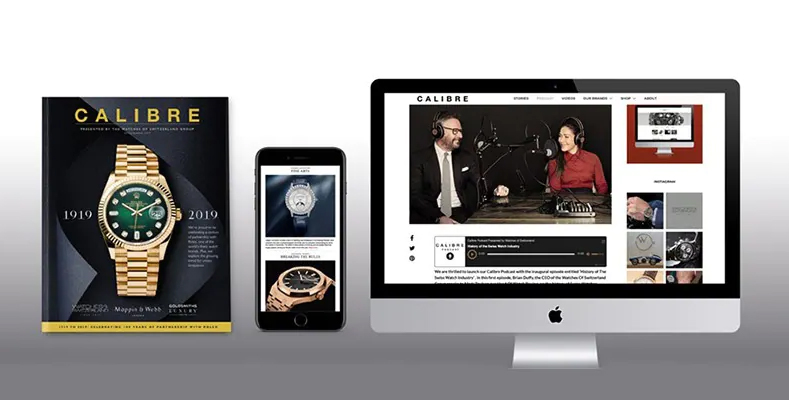WatchBox’s new global editorial director, and ex-Hodinkee editor-in-chief, Jack Forster muses on whether editorial content and retail sales are still the strange bedfellows that they once were.
It’s as inevitable as it is controversial, writes Jack Forster, your favorite watch blogs have, one and all (almost) become platforms for sales as well.
The thin end of the wedge is usually straps, but as the weeks, months, and years go by, what happens under that ‘Shop’ tab to the far right of the menu bar expands dramatically and before you know it you’re looking at winders, travel rolls, spring-bar tools and, yes, watches for sale.
At the same time, your favorite places to buy timepieces are now in the business of producing stories about watches, which would in the past have been the purview of an enthusiast blog – deep dives into brands, complications and connoisseurship but, of course, always with a view to what you might euphemistically call ‘commercial activations’.
What happens under that ‘Journal’ tab to the far right of the menu bar expands dramatically.
If you are a watch enthusiast, at some point you would like to occasionally add watches to your collection (with frequency and type of watch varying almost infinitely depending on your interests and budget).
But at the same time – maybe most of the time – you’d just like to read interesting stories about watches from fellow like-minded enthusiasts for their own sake, without running across a push to buy something every five minutes.
So, where is the balance? What works, and what doesn’t?
If I had anything like a clear answer to the last couple of questions I could probably spend the next year making seven figures in consulting fees and then get off the hamster wheel and finish my novel.
But the reality is that threading the needle of content and commerce is a tricky business and it has stymied some of the best minds in the watch business and in the online retail business.
There are, it seems to me, two basic paths that are predicated on traditional models of the relationship between content and commerce – traditional and increasingly out of date models.
The first is that a company that began primarily as a commercial platform, decides to move into the production of what would traditionally have been thought of as editorial content.
To some extent it’s always been true that the most successful retailers have been the ones who do the best storytelling although, in the luxury world, the development of good storytelling has been largely the story of good advertising up until fairly recently.

Examples in the watch world include my current gig, WatchBox, which has invested heavily, especially in video storytelling, and Watches of Switzerland which has its Calibre online journal; another good example is Craft + Tailored, which has a beautiful approach to both visual and written storytelling.
The advantage to the commerce of the content trajectory is that there is generally speaking a solid revenue model already in place.
The challenge is that content is (and this is perfectly reasonable) expected to produce conversion to sales in a predictable and consistent fashion.
However, quantifying exactly what the return on investment in storytelling actually is, is notoriously difficult and not always something that can be unambiguously captured.
And that is a problem that is as old as advertising itself.
Too narrow an expectation of conversion can stifle good storytelling before it even gets off the ground, if you’re not careful.
On the other hand, no expectation of conversion can lead to lots of expensive vanity projects whose main purpose is to flatter the tastes of an editor.
The biggest challenge, of course, is that no matter how good your content is, it’s very tough to frame it so that it doesn’t look like a sales pitch.
This is not to say it can’t be a sales pitch, but it is better if it doesn’t look like one.
The second path is for a company that starts out as a content platform.
The revenue for content historically has consisted of exactly two streams: subscriptions, and advertising revenue (and, back when dinosaurs ruled the earth, newsstand sales).
The relationship between advertisers and editorial outlets has always been complicated and in publications of record like the New York Times, innumerable firewalls have always been in place to maintain what the publishing industry refers to as ‘the separation of church and state’. (The satirical news site, The Onion, once published a parody disclosure article on sponsored articles with the motto, ‘Long may the cart of editorial be yoked to the oxen of commerce!’.)
However, the situation today is that readers generally resist the idea of paying one thin dime for content, and so if you have a solid content platform and you don’t want to retire to a cardboard box, you must perforce get into the business side of the business.
Even the New York Times has a shop these days.
The advantage of the content to commerce trajectory is that if a content site has got as far as building out its sales platform aggressively, it probably already has the best practices for good storytelling – or at least, consistently entertaining its audience, which amounts to the same thing – in place.
The problem is that an audience that has been carefully curated and trained to expect good storytelling, with sales taking place as a background activity, can respond poorly to an increase in overt sales pitches – even if tastefully handled.
And the biggest challenge, of course, is that no matter how good your content is, it’s very tough to frame it so that it doesn’t look like a sales pitch, and an off-putting one at that.
It goes without saying that there are a lot of ways things can go off the rails for both content to commerce, and commerce to content, and having a large budget is no guarantee of success – in fact, if you’re not careful having a big budget just means a big opportunity to throw good money after bad.
E-commerce even taken by itself presents a challenge – recently and dramatically exemplified by the Richemont Group’s $2.7 billion exit write-down from Yoox Net-A-Porter.
With so many brands exiting or dramatically reducing their retailer networks in favor of owned monobrand boutiques, being an online AD is a major challenge for both commerce-to-content and content-to-commerce players and the most promising business seems to be pre-owned.
It’s an expensive business to enter, and the volatility in prices for desirable pre-owned watches is second only to crypto in unpredictable fluctuations but it beats constantly worrying that your dearly beloved brand partner is going to unceremoniously dump you after scraping your business model for data.
On a personal note, I have an unshakeable belief in the fundamental value of good storytelling and I think there is no reason why it shouldn’t move the needle commercially.
In fact I think there is every reason to think it can and will.
The trick is, it has to be good storytelling and my experience has been that if you’re delivering that to your audience, then they couldn’t care less if there’s a commercial angle.
But the margin for error is small. Look even slightly opportunistic and you just end up looking cynically manipulative, and our audiences have had 20 years of Internet experience to develop extremely accurate bullshit meters, which is why the rare super-storytellers who couldn’t care less about selling anything (like WatchesBySJX) are worth watching.
However, deliver on real quality, and make absolutely implicit in everything you present that you’re working for your readers, and you stand a better than fighting chance of winning critically and commercially.
Everyone wants there to be some secret sauce that’s a turnkey solution to seamlessly mingling content and commerce but as one of my kung fu teachers used to say, there are no secrets.
Make good stuff, and they will come.


Leave a comment